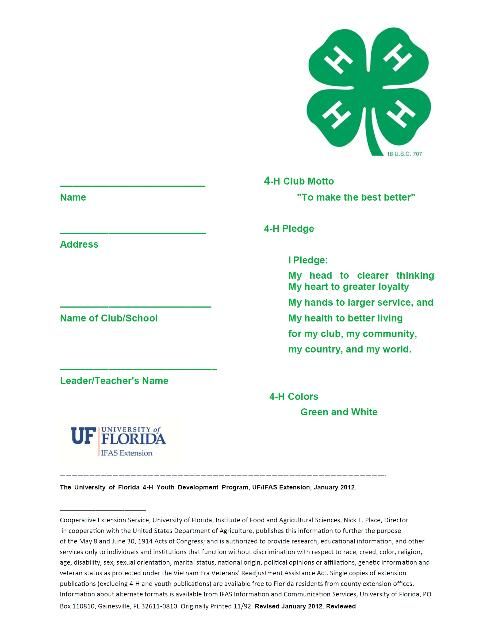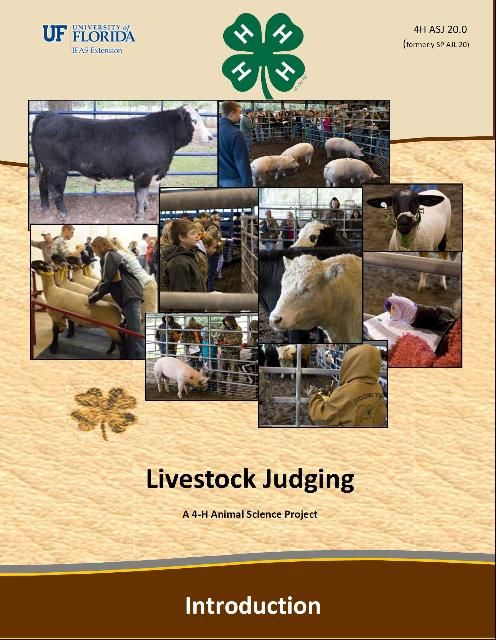
Preface
An Animal Science Curriculum for 11-18 year olds
The Florida 4-H Livestock Judging Curriculum, a part of the OUR LIVING WORLD curriculum framework, includes the basic premise that judging activities provide youth with an excellent opportunity to develop communication, decision making, and organizational skills, and enhance their confidence and self esteem. The 4-H Animal Science program provides an opportunity for young people to practice a variety of life skills while learning subject matter.
Serving as a judging coach or leader can be a very rewarding and educational experience. So often, potential leaders will not become involved because they fear they lack knowledge, qualifications, or experience that they need to work with youth in this area. However, some of the most effective and successful judging programs are organized by leaders who have very little subject matter background. You will have a tremendous influence on the young people with whom you will be working.
To the informed Florida citizen, it is not surprising that animal science commands a priority within the total Florida 4-H education curriculum. An investment in young people's knowledge, understanding, and attitudes about animals affects their lives and cannot be ignored now or in the future.
Table of Contents
I. Introduction
Credits ........................................................................................... 2
Preface .......................................................................................... 3
Table of Contents .......................................................................... 4
About Livestock Judging ................................................................ 5
Activity Profiles................................................................. 6-7
Training A Team Basics ..................................................... 8-11
About Experiential Education ........................................................ 12-13
Overview to Activities ...................................................... 14-17
II. Livestock Judging
TEACHING OUTLINES
Activities
1. Parts is Parts ...........................................18
2. Different Strokes..................................... 30
3. The Bottom Line ..................................... 44
4. What You See Is What You Get! .............54
5. Express Yourself......................................97
6. Judging a Class .......................................115
7. How Do I Rate? ....................................... 117
8. What's My Line? ..................................... 126
9. What's Your Score? ................................ 136
About Livestock Judging...
The development of this 4-H Animal Science Project Kit was driven by two basic principles:
-
Judging activities provide youth with an excellent opportunity to develop communication, decision making and organizational skills, and enhance their confidence and self esteem.
-
4-H volunteer teaching activities must be ready-to-use. This project includes materials needed to conduct livestock judging animal science activities in an easy-to-use format. It was designed to be teacher friendly and takes much of the guesswork out of teaching this subject.
Age or Grade Levels
This project was developed for youth ages 11-18. Both group and individual activities encourage participation and action in all aspects of animal science livestock judging education. Teachers and volunteers should use all of the activities and in the order that they are provided. They were designed sequentially so that youth could build upon skills developed in each activity.
Contents
The following resource is the component of the 4-H Animal Science Livestock Judging Program:
-
LEADER'S GUIDE - This curriculum contains a complete, easy-to-read outline for activities which are a mix of games, experiments, role plays or demonstrations that help to teach the basic principles and concepts of livestock judging. The activities conclude with discussion questions for youth to REFLECT and APPLY.
Activity Profiles
A brief description of the nine LIVESTOCK JUDGING Activities:
Activity 1: Parts is Parts
All animal body parts have a specific function and are necessary for daily survival. Adequate knowledge of parts is essential for evaluation of livestock and participation in the livestock industry. This activity introduces youth to this vital first step: information for livestock judging.
Activity 2: Different Strokes
Like humans, all animals have a genetic make-up. In livestock, it is easy to categorize groups based on their breed and sex characteristics. It is important to be able to recognize and distinguish between the types, breeds, and sexes, and be able to discern ideal type within each breed. This is the next step involved in the livestock judging process and this activity helps youth identify these essential characteristics.
Activity 3: The Bottom Line
This activity introduces youth to the livestock industry and allows them to become comfortable with the ever-changing demands placed on producers. It assists with the idea that producers must have goals for production that equate with economic gain or loss. The industry in which animals are expected to perform has the greatest impact on the selection of desirable characteristics.
Activity 4: Express Yourself
Common terminology is an important consideration when communicating with others in the livestock industry. This activity introduces the basic vocabulary, meanings, and the synonyms that will be crucial to understanding and relating to industry demands and for oral reasons.
Activity 5: What You See is What You Get
The process of visual appraisal and selection involves the weighing of good and bad points of the individual animal. This activity introduces this concept and relays that the emphasis which is placed on each characteristic in visual selection depends on species, breed, sex, age, and use.
Activity 6: Judging a Class
Evaluating an entire class of animals is much easier when you have a plan. This activity builds upon the skills developed and knowledge gained in the previous activities. It solidifies specific concepts which are an essential part of livestock judging.
Activity 7: How Do I Rate?
Performance data is often confusing to livestock judging members who do not understand its purpose and use in placing a class. This activity provides an explanation and rationale for performance data and offers sample scenarios that youth might see in a contest.
Activity 8: What's My Line?
Communication is a key to the future. Being able to express yourself, beliefs, goals, and opinions is a skill that will have great impact on career goals. This activity enhances communication skills and builds on them for lifelong use.
Activity 9: What's Your Score?
This activity explains the basic scoring system used in most livestock judging events. It involves the use of cuts from a perfect score of 50.
Supplemental Online Resources:
http://extension.usu.edu/cyberlivestock/htm/livestock-judging/
http://livestock.colostate.edu/youth/judging/index.html
http://www.youtube.com/watch?v=b2kvkbsV6Xk
http://www.thejudgingconnection.com/education.php
http://www.animal.ifas.ufl.edu/extension/meat/youth/Market%20Hogs%20Eval/Hogs%20All%202010.pdf
http://www.animal.ifas.ufl.edu/extension/meat/youth/Market%20Steer%20Eval/Steers%20all%202010.pdf
Training A Team Basics
Let's review the sequence of events which should be followed to train a judging team. We will assume that you have the team members identified and there is a limited amount of experience among them. Remember that livestock judging is like any other endeavor, not all youth have the same ability, so do not be impatient with hard working slow learners as they benefit greatly from this experience.
The first steps of teaching animal evaluation and selection (judging) are not necessarily taken in the presence of an animal. There is much that youth must understand prior to actually evaluating a live animal. However, one must understand that judging teams are voluntary and should be fun. When the youth cannot differentiate between "judging" and "school", they will lose interest and quit the team. Keep the mix of fun and education, and you will be able to recruit and retain members.
Steps of Teaching Livestock Evaluation
Livestock judging is a science-based art. We certainly have more science incorporated in livestock selection today than ever before, but an element of subjectivity remains when evaluating live animals. There is no equation, magic bullet, or cut and paste scenarios to train youth in livestock judging.
1. Establishment of the ideal animal
-
Animals are ranked on their value, with the ideal animal having optimum value. Animals with more positive traits (or less negative traits) should be placed above those with more negative traits.
-
There is an ideal market animal for each meat-animal species. This ideal market animal should utilize as little feed resources as possible and should generate a carcass deemed desirable relative to the current market conditions. These ideals have changed and will continue to change over time, with differences in consumer preference and production practices.
-
There is also an ideal breeding animal for each species, of both genders. The ideal breeding animal should display the performance, type and reproductive soundness which should allow it to efficiently produce offspring as replacement or market animals. Additionally, animals of different purebred breeds have different genetic strengths and weaknesses, thus the traits of ideal breeding animals differ between breeds.
-
The changes in type for the ideal Hereford market steer over the past 70 years are depicted on the next page.
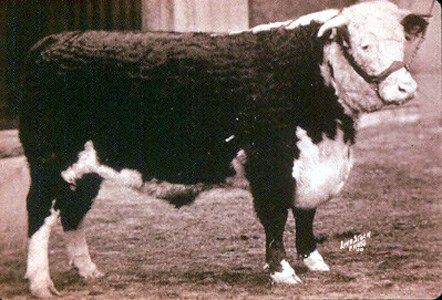
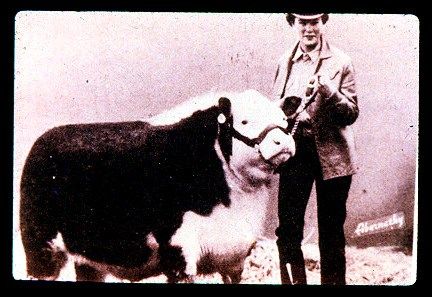
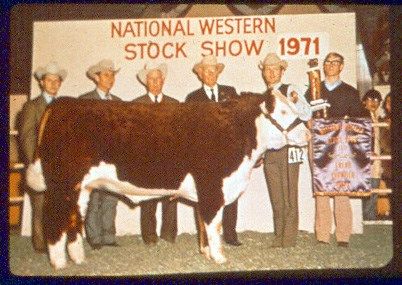
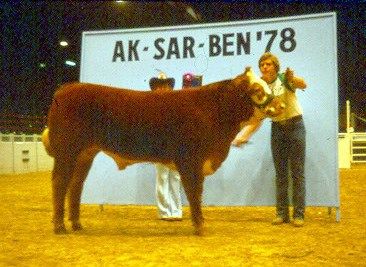
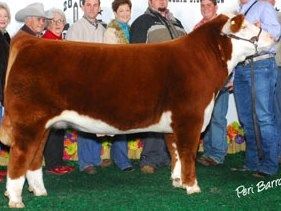
2. Understanding meat-animal production
Students should learn as much as possible about all facets and phases of meat-animal production. A good start can be gained by watching educational DVDs, browsing the Internet, and educational PowerPoint slide shows. Students who understand how all the phases of meat-animal production work together will develop a more thorough understanding of the importance of different traits. The next step is to make as many industry tours as possible. These should not be judging team practice sessions, but true tours complete with a preplanned list of objectives which are given to the tour host before arriving on site. At the conclusion of the tour, be sure to allow time for questions and discussion.
3. Establish the traits which are important to evaluate for breeding and market animals of each species
Students must know what the traits are, the level of performance that is desired, and how to prioritize traits.
-
Visual Evaluation. Beginning judges need a list of priorities for each type of class which they will evaluate. Create a list of priorities for them to use as a guide. For breeding animals, the prioritization of traits will change with given circumstances.
-
Performance Evaluation and Management Scenarios. Performance records and management scenarios may be provided on classes of breeding animals. This may include the actual performance records, adjusted ratios, or expected progeny differences (EPDs) for growth, reproductive, carcass, or convenience traits. Students will be given scenarios of how the breeding animals will be used in production and what will occur with their offspring.
Students should receive classroom instruction on what different performance records mean and how they should be incorporated with live evaluation and the given management scenario.
4. Establish correct terminology to communicate with others in meat-animal agriculture
Much of the terminology and many of the phrases used within meat-animal agriculture is unique, so students who do not use the proper terminology will not be understood by others in animal agriculture. Students must know the proper terminology to describe body parts of animals and understand how to properly describe differences between animals. A strong grasp of proper terminology for body parts and functions will be necessary for students to become successful with oral reasons.
5. Teach students to communicate and defend their placing
Oral reasons are a brief (1-2 minute) justification of why animals were placed a given way. Generally, reasons are scored on accuracy, organization, and oral presentation and delivery. Reasons are given to one official in a private setting. Teach students to be natural, comfortable, and conversational when describing their placings to officials.
The Experiential Process...Steps and Techniques
The 4-H Program has a long history of providing for a cooperative teaching—learning process between adults and youth. The activities in each project lesson strive to involve young people in experiences that require them to interact, analyze, question, reflect, and transfer what they have learned to personal application. The activity comes first, the "learning" comes from the "discovery" of new knowledge and skills as a result of the experience. This is the 4-H "learn-by-doing" process. However, to end with the experience without building upon it through REFLECTING and APPLYING does not help the young person understand the significance of what he/she saw, heard, or did. It is the transfer of this significance from one experience to another that helps young people apply their "learning" in future situations.
Do. Each lesson topic identifies the activity or series of activities to DO involving youth in a common EXPERIENCE.
Reflect. At the conclusion of the activities, allow time for the youth to REFLECT (share and process) what they learned from the experience. Each lesson guide outlines some key questions to assist you in this process.
Apply. Help youth to APPLY their new knowledge and skill to real life situations. You can do this by helping them to identify key principles that are important for future decisions or personal action. Again, each lesson has outlined a few questions to direct this process.
Steps
This model illustrates the cooperative teaching-learning process that is used in the 4-H curricula. A further description of the steps in the process may be helpful as you become an active facilitator of Livestock Judging!
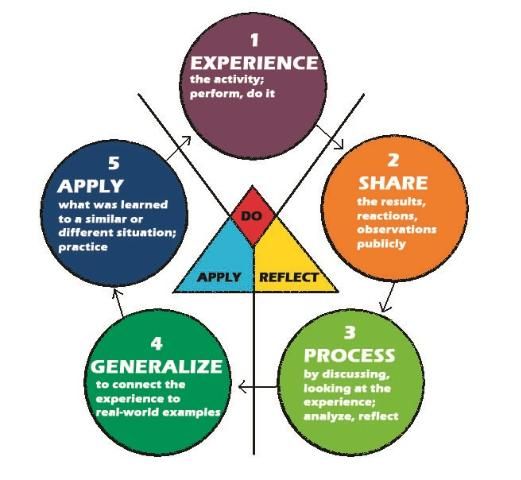
Experience– Begin with concrete experience. This can be an individual activity or a group experience, but it involves "doing something."
Share—Next, get the participants to talk about the experience. Share reactions and observations. Let the group talk freely. Acknowledge ideas; listing them visually is helpful. Encourage group members to answer questions posed by others. Avoid having the leader answer questions.
Process—Discuss how themes, problems, and issues are brought out by the exercise. Speak to specific problems and issues that the group discovers from the exercise or recalls from personal experiences. Look for recurring themes.
Generalize—Find general trends or common truths in the experience. Draw out and identify the principles that are important– that apply to "real life", not just the activity. This focuses on the key messages.
Apply—Concentrate on how the new learning can be applied to everyday situations. Discuss how issues raised by this activity can be useful in the future. Describe how more effective behaviors can grow out of what is learned.
Techniques
Use a Variety of Activities
You might consider any one or a combination of the following: tours, interviews, judging, games, pantomimes, skits, puzzles, demonstrations, problems to solve, experiments, using a specific tool, systematic observations, creating a product, visualization, brainstorming, group initiatives, case studies, simulations, surveys leading to an event or activity, or sharing and presenting to others through talks and exhibits.
Develop Questions to Ask
The types of questions asked will vary with the activity; some questions may relate to the content but some must go beyond it. If a specific life skill is to be enhanced, then the youth should have the opportunity to become as involved with understanding the life skill as understanding the subject related skill. Questions to help move in this direction may be as straightforward as these examples:
Sharing Questions
1. What did you do?
2. What happened?
3. How did you feel?
4. How did it feel to...?
5. What was most difficult? Easiest?
Processing Questions (Use data generated from sharing questions)
1. What problems or issues seemed to occur over and over?
2. What similar experiences have you had?
Generalizing Questions
1. What did you learn about yourself through this activity?
2. What did you learn about life skills, (e.g., making decisions)?
3. How do the major themes or ideas relate to real life and not just the activity?
4. How did you go about making your decision?
Applying Questions
1. How can you apply what you learned (making decisions) to a new situation?
2. How will the issues raised by this activity be useful in the future?
3. How will you act differently in the future as a result of this activity?
Each of these general questions could be enhanced by adding specific language referring to the experience in a particular project.
Each activity begins with this list outlining the key concept and objectives and skills that is the purpose of the activity, the materials needed, time, and any advance prep you will need to do.
Overview to Activities
Each activity outlines begins with the EXPERIENCE—what you do with the youth—this is the summary of all activities in the manual.
Do - Learning New Knowledge and Skills
-
Discover animal body parts and proper terminology in PARTS IS PARTS.
-
Investigate species breeds and sex characteristics in DIFFERENT STROKES.
-
THE BOTTOM LINE introduces the importance of industry and individual demands in livestock judging.
-
Discover industry priorities through WHAT YOU SEE IS WHAT YOU GET!
-
EXPRESS YOURSELF improves communication skills, develops memory skills and instills confidence.
-
JUDGING A CLASS ties the knowledge gained together.
-
Analyze performance data in HOW DO I RATE?
-
WHAT'S MY LINE? introduces the contest component oral reasons.
-
Discover the scoring system for livestock judging events in WHAT'S YOUR SCORE?
Reflect - Sharing and Critical Thinking about Experiences
Then the activity provides you with questions (and answers in bold) to assist you with reflection—assessing what youth have learned. Here are some questions to use for the final review once you have completed all the activities in the manual.
What parts have a similar name and location on all three species?
Loin, cannon bone, knee, hock, pastern
Why is it important to identify the body parts?
The knowledge of body parts is an important foundation of knowledge to build on within the livestock industry and judging events. You will use this knowledge to communicate with others, evaluate animals and understand how animal parts are put together in the live animal.
How are breeds and species different?
A breed is a group of animal with similar traits within a species
What is the bottom line in the livestock industry?
Profitability
Do industry goals affect the individual producer?
yes, the producer must know what kind of animal the industry demands in order to raise a marketable product.
Why are some animal cuts more expensive than others?
Cuts that contain more connective tissue (in lower leg and shoulder) will not be as tender as cuts found in the loin and upper regions of the animal. These less tender cuts often require more cooking time and have to be cooked in a moist cooking method (i.e. pot roast). For this reason, people are willing to pay the extra money to have the cut that is tender and requires less cooking time.
Why is there a variety of ways to express the same thing?
To provide ways to express a certain trait in almost any situation; to give some variety to a set of reasons.
When selecting a market animal, which trait is most important?
The animal's potential carcass value, as evaluated by muscling, external fatness, and animal weight.
Which traits are especially important if you are breeding a bull to a group of yearling heifers?
A low birth weight record and desirable calving ease score are crucial in this situation, because heifers usually have a difficult time delivering large calves and the calves and/or heifers could die as a result of calving problems (called dystocia).
What is an official "cut" when judging a class of animals?
The points that are subtracted when the animals are placed incorrectly
Apply - Act on New knowledge
The ultimate outcome from any of the 4-H learning experiences and activities is for youth to apply the knowledge and skills to future situations. Each of the activities provide with ideas to help youth apply what they have learned in a variety of ways—from completing activity tasks, being able to engage in a quality discussion within the industry, applying the knowledge to their daily life. For this particular project being successful at judging and selecting quality livestock as well as applying the same principles and practices to any decision-making opportunities in future.
Here are some sample ideas for wrap-up and application activities for youth at the conclusion of their livestock judging activity sessions.
-
Use blank copies of each Parts of the Animals to test youth's memory of the parts at future meetings.
-
Complete the FULL OF CHARACTER Crossword puzzle.
-
Take an industry tour of an animal operation.
-
Visit the meat department at a local grocery store and inspect the meat cuts and their prices
-
Show a picture of an animal and have the youth describe it on its own merit using proper terminology.
-
Set up a field trip to a ranch, livestock market, farm or fair to evaluate livestock.
